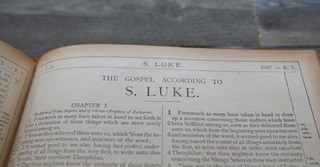Who Is Caiaphas in the Bible?
Share

The ancient Roman rulers played a crucial yet controversial role in first century A.D. Jewish leadership.
At the time of Jesus’ earthly ministry, Rome experienced Pax Romana (27 B.C.-A.D.180). This Latin phrase for Roman peace overshadowed all their dealings with every nation under their subjection.
The governing authorities quickly quashed insurrections and disturbances of any kind. A known “rabble-rouser” in a small district of Judea threatened the peace, and Rome would not stand for it. Enter Caiaphas, the high priest of Judaism.
Who Was Caiaphas’ Importance?
Caiaphas (full name, Joseph Caiaphas), a Sadducee, operated as the Jewish high priest in the Jerusalem temple, and he presided over the Sanhedrin during Jesus’ time on earth. As mandated by the Lord, only Aaron’s descendants could be true high priests, and Caiaphas and his father-in-law, Annas, were appointed to their positions by Roman governors.
The high priest’s functions included overseeing the sacrifices and other rituals, which were regular events at the temple. His most significant duty would have taken place on the Day of Atonement when he alone entered the Holy of Holies to request God’s forgiveness on his and the entire nation’s behalf. The Holy of Holies was the innermost chamber of the temple, which housed the ark of the covenant and the presence of God.
In addition to his role as high priest, Caiaphas came under the direct authority of the Roman governor (he served under two: Quirinius and Gratus). He wielded power to appoint a high priest of his choice. The governor could also use self-serving political influence and take custody of the high priest’s sacred vestments.
Both Annas and Caiaphas were appointed as high priests through extant sources (e.g., Josephus, Antiquities of the Jews). That begs whether they were indeed Levites, but it is more likely than not they were. This is too huge a question for this article, but it is worthy of further study. Indeed, though, Caiaphas was instructed and held excellent knowledge of Jewish law and rituals. He also had a “friendly” working relationship with the governor. He kept the Jews peaceful and preserved Judea as an integral part of the Pax Romana.
The question is also why two high priests are mentioned as serving simultaneously (Luke 3:2; Acts 4:6). As Caiaphas’ father-in-law, Annas served until deposed by Gratus. The subsequent two high priests included one of his sons, but neither made it past a year in the post. When Gratus appointed Caiaphas, Annas still held sway with the religious leaders and Rome. His emeritus position, power without an official title, and the possibility of skillful diplomacy and perhaps with bribery, Annas proved able to keep his family, including his son-in-law, Caiaphas, in a leadership role for years.
What Role Did Caiaphas Have with Jesus?
When Jesus began His ministry, Annas had been deposed for over ten years, and Caiaphas had been in office since A.D. 18. Jesus regularly taught in the temple (Matthew 26:55), and as He taught, he invoked first the ire and then the rage of the Jewish ruling elite, who considered themselves the “keepers of all things” on the Law and the Prophets. Their plot to kill Him came to fruition as recorded in Matthew 26:1-5.
The four gospels tell us Caiaphas had a principal role in Jesus’ last week. But before those momentous seven days, the Sanhedrin (along with Caiaphas) heard testimony about the miracles Jesus performed, especially right after Jesus resurrected Lazarus. They convened a council and said, “If we let Him go on like this, all men will believe in Him, and the Romans will come and take away both our place and our nation.” Caiaphas told them they knew nothing at all, “nor do you take into account that it is expedient for you that one man should die for the people, and that the whole nation should not perish. As high priest that year, he “prophesied that Jesus was going to die for the nation, and not for the nation only, but that He might also gather together into one the children of God who are scattered abroad” (John 11:45-54). It was Caiaphas who instigated the plot which became a reality as “from that day on they planned together to kill Him” (John 11:53).
Jesus—when He was arrested—first endured a trial before Annas (John 18:12-13), who asked Jesus about His disciples and His doctrine (John 18:19). Annas’ officers took exception to Jesus’ answers and struck Jesus (John 18:22). After the questioning, Annas sent Jesus bound to Caiaphas (John 18:24).
Mark 14:56-64 is a very telling passage regarding Caiaphas’ role in Jesus’ trial before the Sanhedrin. “For many bore false witness against Him, but their testimony did not agree. And some stood up and bore false witness against Him, saying, ‘We heard Him say, ‘I will destroy this temple that is made with hands, and in three days I will build another, not made with hands” Yet even about this their testimony did not agree. And the high priest [Caiaphas] stood up in the midst and asked Jesus, ‘Have you no answer to make? What is it that these men testify against You? But he remained silent and made no answer. Again the high priest asked Him, ‘Are you the Christ, the Son of the Blessed?’ And Jesus said, ‘I am, and you will see the Son of Man seated at the right hand of Power, and coming with the clouds of heaven. And the high priest tore his garments and said, ‘What further witness do we need? You have heard His blasphemy. What is your decision?’ And they all condemned Him as deserving death.’”
Here Jesus referred to His position as heavenly Judge when He called Himself “Son of Man.” The Accused will judge His accusers, and all the chief priests, elders, and the scribes recognized the title from Jesus’ quotes of Psalm 110:1 and Daniel 7:13. Their rage caused some of them to “spit on Him, and to blindfold Him, and to beat Him. Others said, “Prophecy!” And again, He was struck by the officers. (Mark 14:65)
What Happened to Caiaphas and Why Was He Removed from Office?
Caiaphas was a high priest for eighteen years (A.D. 18-36), the longest reign of any high priest in New Testament times (the standard term lasted less than three years). He served under Pontius Pilate and, in A.D. 36, Vitellius, the governor of Syria, removed him from his position. Yet Annas’ influence continued as Jonathan, another of his sons, took office after Caiaphas. (Josephus, Antiquities of the Jews).
Caiaphas’ history was tied to Pontius Pilate’s for a season. In A.D. 36, a man who claimed to be a re-embodied Moses amassed an armed group of followers. Pilate squelched the mob and executed some members. The Samaritans complained to the Syrian governor, Vitellius, and Pilate was “retired.” It may be that since Caiaphas was so interlocked with Pilate, his role was terminated as a result of Pilate’s use of force once a new governor came into power. We do not know for sure.
Five Interesting facts about Caiaphas, His Family, and the High Priesthood
1. An interesting poem was written in the Talmud about Annas’ family (It is very telling about how the orthodox Jews felt about them):
“Woe to the house of Annas!
Woe to their serpent’s hiss!
They are the high priests;
Their sons are keepers of the treasury,
Their sons-in-law are guardians of the temple,
And their servants beat people with staves.” (Pesahim 57a)
2. An exciting archaeological discovery in Jerusalem in November 1990 revealed a burial cave. Because of the markings on an ossuary found in the cave, it was concluded the bones were that of Caiaphas, the first physical remains of a person mentioned in the Bible.
3. Caiaphas is mentioned in Acts 4:6 as one of the high priests who threatened John and Peter when they spoke about Jesus after His resurrection.
4. It is supposed that there were eighty-three high priests throughout Jewish history. Aaron was the first and the last, Phannias (A.D. 70).
5. A high priest must’ve been free from every bodily defect, according to the Old Covenant (Leviticus 21:16-23).
Looking at the role of a chief priest during Roman rule gives us pause to consider the pressures of the position. It’s easy for us in hindsight to condemn Caiaphas as an evil politico who was hostile to Jesus for his own self-serving interests.
But Caiaphas knew the Law. He knew the prophesies. He chose to be an enemy to the Lord for status, and sadly it’s something we witness in our day. Caiaphas himself condemned Jesus before the Sanhedrin, and he saw what he wanted to see to affect his relationships with the Jewish leaders and the Roman authorities. In his effort to keep peace with Rome, he defamed and initiated the death of the only One who can bring true and lasting peace—Jesus Christ.
Photo credit: ©Playbackmedia.com/Sparrowstock
